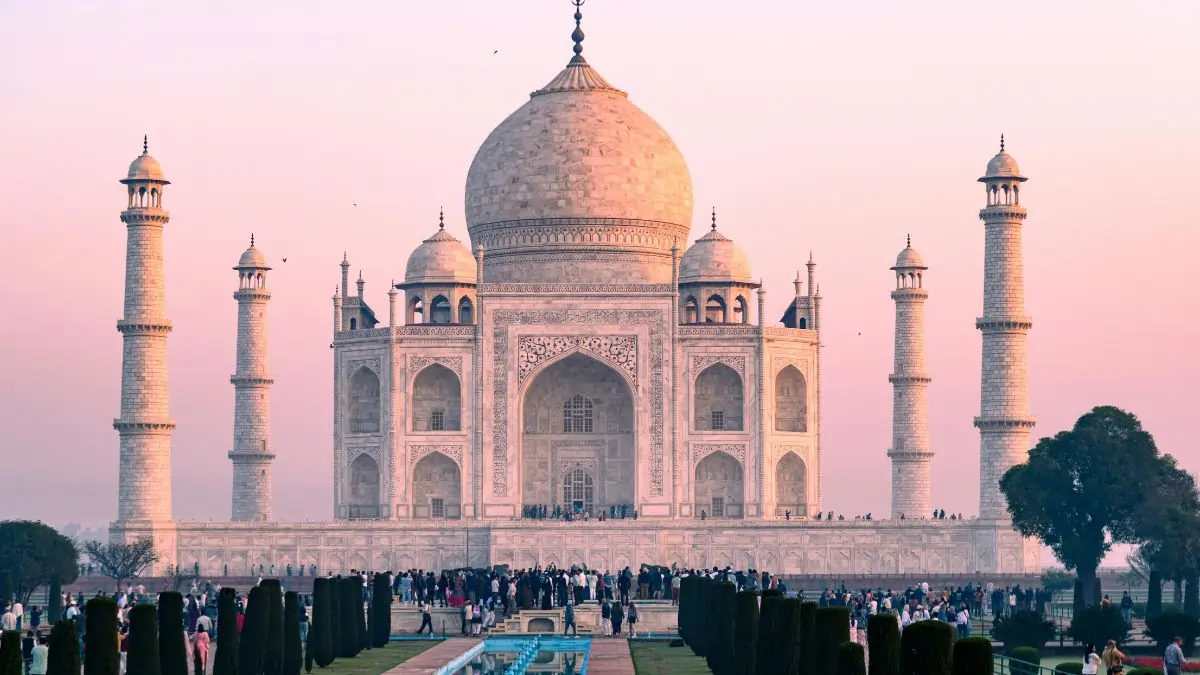
If you’ve been willing to explore the Taj Nagri of India, but the idea seemed to be too daunting, we have curated an Agra Tour Itinerary. It will help you explore the most popular tourist places to visit in Agra. It covers an area of 4027 km sq. and an elevation of 170 m., Agra has established itself as a prominent tourist spot.
When planning to explore Agra, the most common mistake people make is to visit only the Taj Mahal. Most of them are unaware of the fact that there are many other places to see in Agra. However, there are other places around this iconic monument which can be easily covered on your 2 days Agra Tour Package. Continue reading this article to know more about the places to cover on a guided Agra tour.
Best Places to visit in Agra
1. Taj Mahal
Located on the banks of the Yamuna River, the Taj Mahal is a monumental ode to eternal love. The 17th-century mausoleum was built for Mumtaz Mahal by her husband and Mughal Emperor Shah Jahan. The Taj Mahal brilliantly represents the height of Mughal architecture. The grandest mausoleum was commissioned for his favorite wife Mumtaz Mahal.
2. Mughal Gardens
After taking a tour of the minarets, tombs and the entire monument, you can sit and relax at the Mughal Garden or just take a stroll along it. A reflection of the concept of a “Paradise Garden”, the idea of Charbagh or a Mughal Garden around the Taj was inspired by the Persian gardens. It enhances the beauty of the entire complex and has a long avenue of trees laid out according to their scientific names.
3. Itmad-ud-Daulah Tomb
The ancient Mughal tomb is also known as the ‘Baby Taj’ of Agra. It looks exactly like a miniature version of the Taj Mahal. Located on the eastern banks of the Yamuna River, the tomb of Mirza Ghiyas Beg has a resplendent architecture and intricately carved jalis or window screens. Take a walk around the monument, after which you can leave to explore the Mehtab Bagh.
4. Taj Museum
By the time you soak in the beauty of the Taj and spend some time, pondering over life in the Mughal Gardens, it will be afternoon. The Taj Museum is the place where you can observe authentic Mughal miniature paintings including, the original ivory portraits of the emperor Shah Jahan and his wife Mumtaz Mahal. Besides the paintings, take a tour of the museum and you’ll find gold and silver coins, etc.
5. Agra Fort
The magnificent Agra Fort was built during the reign of the Mughals. It is a 94-acre structure located along the banks of the Yamuna River. If you’re planning a trip to Agra, then ensure that you include this erstwhile residence of the Mughals in your Agra sightseeing tour.
6. Mehtab Bagh
Conceived long before the Taj Mahal came the powerful emperor Babur who constructed the Charbagh also known as Mehtab Bagh. Located on the north side of the Taj complex is full of greenery and provides a perfect view of the Taj Mahal.
7. Akbar’s Tomb
Located around 15 kms from the Taj Mahal, Akbar’s Tomb is in Sikandra. The suburbs of Agra, take some time to soak in the legacy of one of India’s most important Mughal Emperors – Akbar. The tomb is adorned with minarets and inscriptions on the walls and has red sandstone structures.
8. Jama Masjid
The famous mosque was built by the daughter of Shah Jahan – Jahanara. It is one of the biggest mosques in India and is known for its splendid architecture. The red sandstone construction and intricate designs on the tomb will leave you astounded.
9. Fatehpur Sikri
Located near Agra, Fatehpur Sikri is a fortified city built to serve as the capital of the Mughal Empire during the late 16th century. The historical city is now a UNESCO World Heritage Site and is one of the prime tourist attractions of Agra. The saint foretold the birth of his heir and when the prophecy was fulfilled.
Conclusion
Agra offers a rich tapestry of historic and cultural experiences. From grand architectural marvels to serene gardens, Agra presents a blend of historical significance and architectural splendour. So, plan your Agra tour package with Trip Plan India and get the most amazing experience with the spirit of its past and present.




